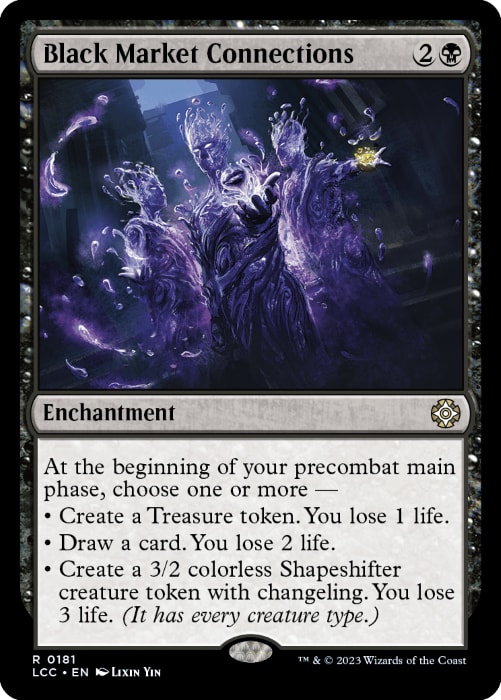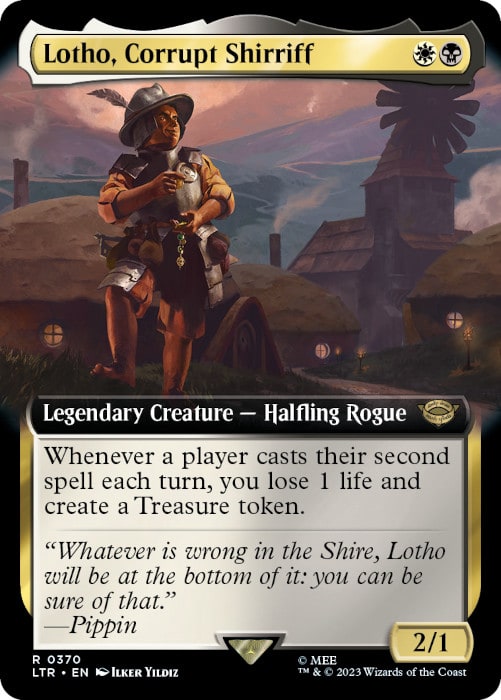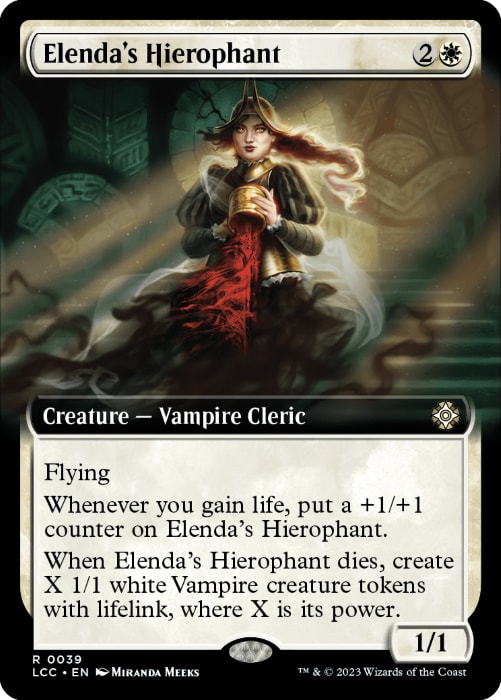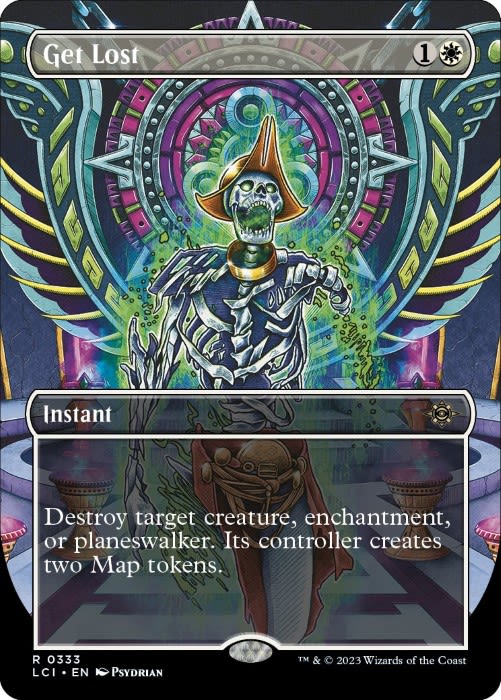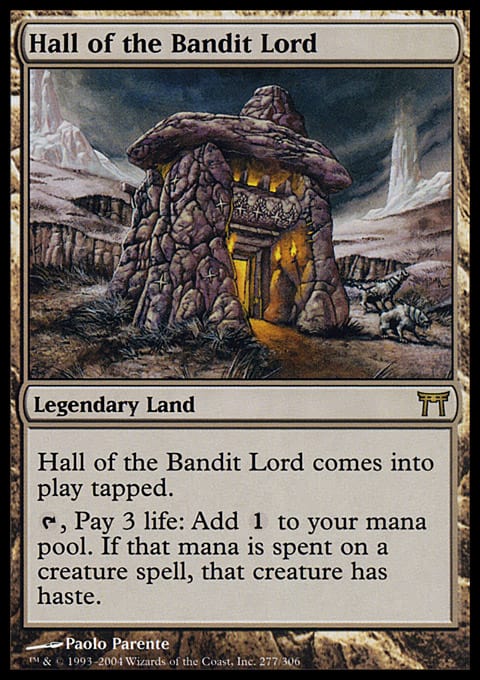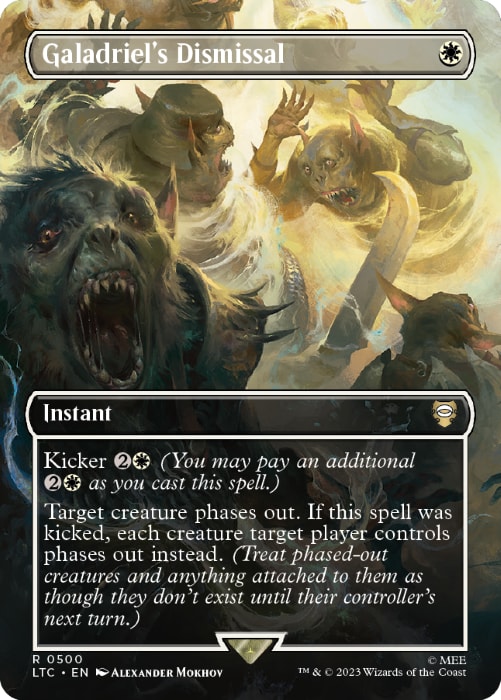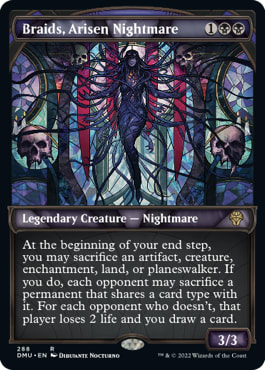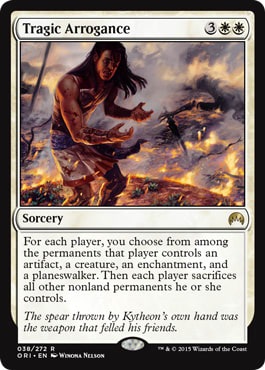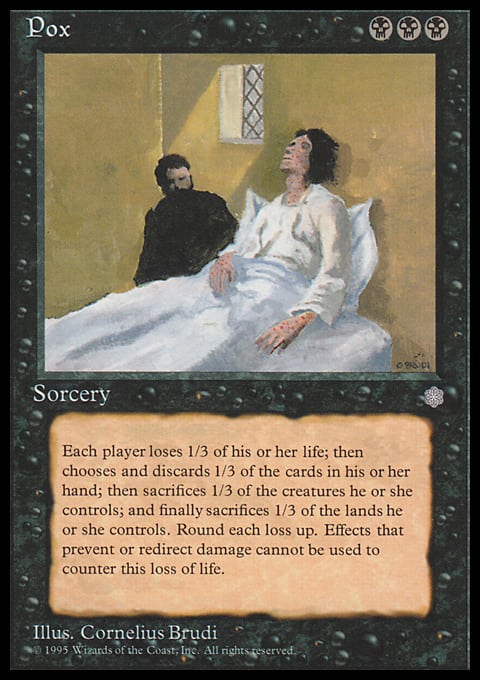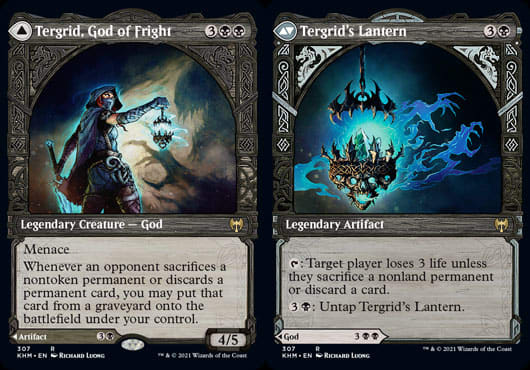If there's one thing I enjoy in Magic: The Gathering, it's filling my graveyard. I love using my graveyard as a resource, an ever-growing toolbox full of creatures I can bring back. I adore decks that can treat it as an extension of your hand, I love abusing the graveyard to cheat in powerful creatures, I'm particularly fond of combos that involve it, and few things make me as happy as a turn one Faithless Looting. My playgroup knows to be nervous when they see me with a full graveyard, and the majority of my multicolored Commander decks contain Black. That's just the sort of player I am.
I've taken many a loss to a Rest in Peace or a Bojuka Bog. I always do my best to be gracious when it happens. Graveyard strategies can be very powerful, and ways to counter them are important to the game's health. I know this. At the same time, though, there's nothing quite as gut-wrenching as facing down a Remorseful Cleric across the table. Despite my best efforts, it can make me a bit bitter. Bitter enough to want to force them to join in on my fun. Figuratively speaking, of course - they won't be having much fun. This was part of the thought process that birthed a deck I remember very fondly.
I've always enjoyed decks that sacrifice many of their own permanents, so when Mazirek, Kraul Death Priest was printed, I quickly built a deck around him. As I built that deck, however, I made a discovery that led me down a dark road. Much like an unfortunate European peasant during the era of the crusades, I discovered Smallpox. Any card that forces your opponents to sacrifice lands is going to draw a lot of ire, but setting them back was never my goal. My goal was to put eight +1/+1 counters on all my creatures. Because Mazirek triggered whenever anyone made a sacrifice, any spell that could make each player sacrifice multiple things scaled incredibly well in multiplayer games.
That deck might be gone now, but its legacy still remains. For a while, I had a Korvold, Fae-cursed King deck, but it was difficult to manage the deck's power level with such a strong commander, and he didn't work well with Smallpox, which was a pity. For a brief, shameful moment, I very nearly built Tergrid, God of Fright // Tergrid's Lantern before coming to my senses. That should give you a decent idea of how desperate I was to give Smallpox a home.
That brings us to The Lost Caverns of Ixalan, and the subject of this column, Carmen, Cruel Skymarcher. At a glance, the similarities between Carmen and Mazirek are quite apparent. Both are five mana 2/2s with flying, along with a triggered ability that creates +1/+1 counters whenever a player sacrifices a permanent. This makes the two cards extremely easy to compare. By picking Mazirek, you get to put counters on your entire board, and with Carmen, you have lifegain and a reanimation engine in your command zone. Of course, you're also making the choice between Golgari (![]()
![]() ) and Orzhov (
) and Orzhov (![]()
![]() ) colors, but I'll leave that out of the picture, for now.
) colors, but I'll leave that out of the picture, for now.
In comparison to a Mazirek deck, a Carmen deck is naturally going to be more centralized around its commander. One of Mazirek's strengths is his ability to make even an army of 0/1s into a credible threat with a sacrifice outlet, and Carmen isn't capable of doing that. Because of this, it's not as beneficial to focus on flooding the board with creature tokens. Instead, you'll be relying on Carmen for your win condition more often. As a flying commander that rapidly gains +1/+1 counters, she's comparable to a card like Ishai, Ojutai Dragonspeaker. Carmen costs more and needs more active support from your deck, but she can also grow at a far more explosive rate. That isn't all she does, of course. Life gain can help insulate you from threats and enables synergy with cards that trigger off of life gain, and her reanimation trigger on attack can let you reuse sacrificed permanents.
Where in the World is Carmen Sandiego?
Our gameplan is going to center around ramping out Carmen, protecting her from removal, sacrificing things, and making the rest of the table sacrifice things.
Starting with a format staple, Black Market Connections is an unbelievably stacked card that was just reprinted, and does essentially everything this deck could ask for. On your upkeep, you can pay one life for a treasure (an artifact token that sacrifices itself for mana), two life for a card, or three life for a 3/2 changeling. Sorry, did I say "or"? My bad, you can choose any number of those options. It might seem scary to pay six life every turn to "full send", choosing all three options, but the sheer amount of value this card generates more than makes up for it, especially here. The treasure can be used to play Carmen on turn four, and afterwards, spending your treasures will trigger Carmen, not only giving her counters, but also refunding the life you spent on them. Card draw is universally powerful, and the creature token doesn't just have a sizable body, we can also use it as sacrifice fodder.
Lotho, Corrupt Shirriff is a 2/1 that gives us a treasure token every time a player casts their second spell each turn, at the cost of one life each time. While this ability may remind you of Monologue Tax, Lotho is far more reliable, since he can trigger off of your own spells. This doesn't leave you at the mercy of whether your opponents decide to cast multiple spells a turn. Treasures are a powerful form of ramp, and they synergize incredibly well with our commander. Because Carmen triggers whenever anyone makes a sacrifice, if our opponents play their own cards that make treasures, we'll benefit. In today's Commander format, where treasure cards are ubiquitous, this can be incredibly powerful.
We'll want more than just treasures to make sacrifice fodder, and one of the best sources of fodder is Ophiomancer. For only three mana, the ability to create a 1/1 snake token on every single upkeep is incredibly powerful. Because the snake tokens have deathtouch, they're excellent at deterring attacks from opponents. If you don't block, and you happen to have a sacrifice outlet, you can sacrifice your snake at the end of each turn for the Carmen trigger, and you'll get it back before it could possibly matter that it was gone.
Like our commander, Elenda's Hierophant was also first printed in The Lost Caverns of Ixalan's commander precons, and fittingly, the two cards work very well with one another. While we don't have many sources of lifegain outside of Carmen, her triggers more than justify using it. So long as both cards are in play, Elenda's Hierophant will grow stronger with every Carmen trigger, and when it dies it will leave behind a pile of lifelinking vampire tokens. Not only can these tokens be sacrificed to trigger Carmen even more, the synergy runs even deeper. You see, after Elenda's Hierophant dies, Carmen's attack trigger can bring it back, leaving you with both an army of vampire tokens and a Hierophant ready to make even more. This is made even better by the fact that the tokens have lifelink. Combine that with the fact that Elenda's Hierophant triggers on life gain, and you might realize that the Hierophant will grow whenever these tokens deal damage.
Despite Roaming Throne being a new card, it's swiftly proving itself to be a Commander staple. Passively duplicating triggered abilities is a powerful and unique effect, enough so that Roaming Throne is seeing a sizable amount of play in non-typal decks where it's just naming one of the commander's creature types. Unlike the preconstructed deck Carmen originates from, this deck isn't vampire typal, so we'll be running Roaming Throne primarily for our commander. It works excellently with a few other cards, including Elenda's Hierophant, but that's mostly a byproduct. With Carmen, Roaming Throne will not only double the rate at which she gets counters and gains life, it will also allow you to reanimate two permanents with her attack trigger.
Yet another new card, Get Lost might seem a bit odd for me to highlight. I don't usually talk much about removal spells, but I'm using this opportunity to get up on a soapbox and say that this card has been criminally overlooked by the Commander community. In White, on a two-mana instant, there's nothing else that can remove such a wide breadth of targets. Yes, the downside of giving an opponent two map tokens is meaningful, but I think the spell's versatility is more than worth the cost. In a Carmen deck, it's hardly even a downside, since an opponent sacrificing a map will also pump our commander.
This two-color deck is playing six fetch lands. I don't normally do this. In my experience, two-color decks don't typically need the color fixing they specialize in providing. They mostly just inflate deck prices for minimal gain. In Carmen, however, I have a good reason for doing this, and you might've guessed what that is.
Yes, it's the word "sacrifice". It's nice to occasionally have a land drop inflate our commander for mostly free. In addition, they help supply targets for Carmen's attack ability, in case our graveyard ever runs dry. My reason for only running the off-color fetchlands that get swamps is quite simple. This deck is predominantly Black, with many of our most powerful sacrifice spells requiring two or even three Black mana.
Hall of the Bandit Lord is another land worth mentioning. Its drawbacks are plentiful. Hall enters the battlefield tapped, only produces colorless mana, and deals three damage to you when you tap it, but it's also a free, colorless source of haste. Creatures cast with the mana gain haste, and this makes Hall of the Bandit Lord a perfect way to get Carmen growing and reanimating things as quickly as possible.
There in the World is Carmen Sandiego
Once we have Carmen in play and ready to attack, how can we actually draw the game to a close? Our gameplan is to set up Carmen, keep her on the battlefield, stack counters on her with sacrifice effects, and win the game with commander damage in the air. While this gameplan does leave us vulnerable to repeated removal, Carmen's secondary role as a recursion engine and source of life gain will help us survive more drawn out games.
Unsurprisingly, as a commander that gives herself +1/+1 counters, Carmen benefits enormously from The Ozolith. For only one mana, it allows you to preserve Carmen's counters in case she's removed. This helps reduce our vulnerability to removal, preserving our momentum when our counters would otherwise be lost.
Galadriel's Dismissal is another card mostly here to help Carmen stay alive. Or rather, stay undead, I guess. Phasing out any creature for only one mana is an incredibly versatile effect. Using it on Carmen can allow her to survive nearly any effect that could otherwise remove her, and casting it on an enemy combo piece can buy you an extra turn. Its three-mana kicker effect allows you to instead phase out each creature a player controls, protecting multiple creatures, phasing out attackers to negate combat damage, or phasing out flying blockers so Carmen can get in.
Braids, Arisen Nightmare will be the first of our cards that specialize in forcing other players to make sacrifices. Considering that, Braids is surprisingly kind. During your end step, you can sacrifice something, and each opponent has the option to sacrifice a permanent sharing a card type with it. Of course, if they don't, they lose two life and you draw a card. Note, that's a card for each opponent that doesn't make a sacrifice. Cards that allow an opponent to make a choice are often weak, but the Carmen triggers and card advantage Braids can provide are powerful enough to subvert that norm.
Many of our most powerful cards are ones that can cause huge numbers of permanents to be sacrificed, and Vona's Hunger is a great example of that. Normally, this instant has a simple edict effect, forcing each opponent to sacrifice a creature. However, it also has Ascend. When you cast it, if you control ten or more permanents (a trivial requirement in most games of Commander) you gain the City's Blessing. If you have the City's Blessing, Vona's Hunger will instead force each opponent to sacrifice half of their creatures, rounded up. If any of your opponents have an impressive army of creatures, this spell can single handedly give Carmen upward of ten counters, enough to kill an opponent in two swings.
Most Commander decks should be running at least a few board wipes, but in this deck, finding the right ones was a bit difficult. Naturally, as a commander-centric deck, we'll benefit from running board wipes that can spare our commander. Some of those board wipes cause permanents to be sacrificed, which sounds excellent, but leads to a problem. Most sacrifice-based board wipes allow your opponents to choose what they keep. This is less than ideal. Tragic Arrogance solves this problem by allowing us to make the choices. While each player will keep some of their board, you can always ensure they keep their least threatening cards of each type. Notably, if an opponent has a permanent with multiple subtypes, such as an artifact creature, you can choose it as both the artifact and creature they keep, letting them keep one less permanent.
These last few cards come with a bit of a caveat: by playing them, you might risk losing a few friends. Few enchantments are as ruthlessly efficient at controlling the board as Grave Pact. It's as simple as it is devastating. Whenever one of your creatures dies, each of your opponents must sacrifice one of their creatures. This card generates enormous volumes of Carmen triggers, and can easily lock one or more opponents out of being able to keep creatures on the board.
There's nothing Commander players hate more than having their lands destroyed. I'm not normally one to play mass land destruction, but given that lands are permanents that can be sacrificed, they're excellent fodder for Carmen triggers. Casting Pox is an excellent way to get the table's attention, albeit mostly in a negative way. It not only does it destroy lands, it makes everyone do math. For only three mana, it forces everyone to sacrifice a third of their creatures and lands, discard a third of their hand, and lose a third of their life, all rounded up. So long as you control a single other creature so Carmen can survive, resolving Pox has a very real chance to single handedly make her large enough to kill a player in one hit.
Finally, I need to face my sins. I briefly mentioned her earlier, and what I said was true. I very nearly built a Tergrid, God of Fright deck. In my defense, I wasn't aware of her rock-bottom reputation, at the time, since I wasn't playing much Magic, but that's only so much of an excuse. I kid, of course. Playing Tergrid isn't any sort of mortal sin, but still, people really hate this card. That's understandable, of course. Nobody likes sacrificing their lands, and it's not much fun watching an opponent play with your cards. At the same time, though, I do really like Tergrid. Stealing things is fun. I included her in this list in the hope that she'll be a bit less insufferable if she isn't the centerpiece of the deck.
There Will Be Blood
I haven't played an enormous number of games with this deck, but its performance has been excellent so far. To be honest, I'm not terribly eager to subject my friends to it again. Nobody has enjoyed playing against it. Nobody likes having to sacrifice all their creatures, and it has the classic voltron strategy problem of killing opponents one at a time, giving the survivors more time to draw into an answer or win through a different axis. This has the unfortunate consequence of making it quite likely you kill one or two players quickly, but you can't close out the game, due to Carmen being answered. If the game goes long, being one of the players that died early like this absolutely sucks.
Carmen, Cruel Skymarcher | Commander | Lilian Johnson
- Commander (1)
- 1 Carmen, Cruel Skymarcher
- Creatures (21)
- 1 Bartolome del Presidio
- 1 Bloodghast
- 1 Braids, Arisen Nightmare
- 1 Cathar Commando
- 1 Crashing Drawbridge
- 1 Dauthi Voidwalker
- 1 Demon's Disciple
- 1 Elenda's Hierophant
- 1 Elenda, the Dusk Rose
- 1 Fleshbag Marauder
- 1 Grim Hireling
- 1 Lotho, Corrupt Shirriff
- 1 Merciless Executioner
- 1 Mother of Runes
- 1 Ophiomancer
- 1 Pawn of Ulamog
- 1 Pitiless Plunderer
- 1 Plaguecrafter
- 1 Roaming Throne
- 1 Tergrid, God of Fright
- 1 Viscera Seer
- Planeswalkers (1)
- 1 Liliana, Dreadhorde General
- Sorceries (6)
- 1 Agadeem's Awakening // Agadeem, the Undercrypt
- 1 Blood Money
- 1 Pox
- 1 Smallpox
- 1 Torment of Hailfire
- 1 Tragic Arrogance
- Instants (9)
- 1 Anguished Unmaking
- 1 Dark Ritual
- 1 Deadly Dispute
- 1 Galadriel's Dismissal
- 1 Get Lost
- 1 Malakir Rebirth // Malakir Mire
- 1 Sejiri Shelter // Sejiri Glacier
- 1 Sheoldred's Edict
- 1 Vona's Hunger
- Enchantments (7)
- 1 Bitterblossom
- 1 Black Market Connections
- 1 Dictate of Erebos
- 1 Grave Pact
- 1 Life Insurance
- 1 Revel in Riches
- 1 Smothering Tithe
- Artifacts (18)
- 1 Altar of Dementia
- 1 Arcane Signet
- 1 Ashnod's Altar
- 1 Bolas's Citadel
- 1 Coalition Relic
- 1 Collector's Vault
- 1 Lightning Greaves
- 1 Mind Stone
- 1 Orzhov Signet
- 1 Phyrexian Altar
- 1 Robe of Stars
- 1 Skullclamp
- 1 Sol Ring
- 1 Swiftfoot Boots
- 1 Talisman of Hierarchy
- 1 The Ozolith
- 1 Wayfarer's Bauble
- 1 Whispersilk Cloak
- Lands (36)
- 3 Plains
- 7 Swamp
- 1 Bloodstained Mire
- 1 Bojuka Bog
- 1 Brightclimb Pathway // Grimclimb Pathway
- 1 Caves of Koilos
- 1 Command Beacon
- 1 Command Tower
- 1 Demolition Field
- 1 Fabled Passage
- 1 Fetid Heath
- 1 Flagstones of Trokair
- 1 Godless Shrine
- 1 Hall of the Bandit Lord
- 1 High Market
- 1 Isolated Chapel
- 1 Lotus Field
- 1 Marsh Flats
- 1 Orzhov Basilica
- 1 Phyrexian Tower
- 1 Polluted Delta
- 1 Rogue's Passage
- 1 Shattered Sanctum
- 1 Silent Clearing
- 1 Treasure Vault
- 1 Vault of Champions
- 1 Verdant Catacombs
- 1 Volatile Fault
Tuning this decklist up or down in power might be a bit difficult, as Carmen's power is directly dependent on how cruel you're willing to be. Removing cards like Pox and Grave Pact would reduce the risk that your friends refuse to play with you when you pull out this deck, but their absence would compromise Carmen's explosive power, which would likely require you to pursue a slower, grindier gameplan. There is one card I excluded out of courtesy to my opponents, however.
Forcing each player to sacrifice the majority of their permanents is a backbreaking effect that's almost certain to either end the game or grind it to a slug's pace. If Carmen is in play when Cataclysm resolves, you'll be placed in an incredibly favorable position, your commander all but certain to kill in one blow. Your opponents, meanwhile, will likely be keeping some much less dangerous creatures, while also losing most of their mana. Cataclysm forces your opponents to drop everything they were doing to focus on answering Carmen, lest you pick them off, one by one. If Carmen fails to end the game then and there, you'll still be ahead on life. With each player having to reconstruct a board state before they can threaten to end the game, the game will be significantly extended, and each and every opponent will blame you.
Final Thoughts
This deck's construction has led me on a long and winding road, and my feelings on it are mixed. Carmen is powerful, explosive, and thanks to her attack trigger, remarkably resilient. I love playing weird old cards like Pox, and getting value off of otherwise benign things like fetchlands and treasure tokens is something I find deeply satisfying. Making my opponents fear a commander they didn't previously give much thought is one of my favorite things about playing Commander.
At the same time, though, I don't like being "that guy". You know, that guy. The person at the game store that doesn't mind making everyone else miserable if it means they can win. The person who struggles to build a deck that can't pubstomp casual games. The person who almost built a Tergrid deck. I try not to be that guy. I love my friends, and I respect everyone who plays at my local game store. Even though I do enjoy this deck, I'd feel bad subjecting anyone to it too often.
In a multiplayer format like Commander, we all owe it to one another to respect our opponents, even if we're trying our hardest to win. While there's nothing wrong with building a powerful or annoying deck, it's important to play them sparingly and tactfully. Probably don't play a deck like this again for a while after winning a game with it. Try and communicate the sort of deck you're playing before you start playing, and be courteous when your opponents destroy your stuff. You know what you're doing when you pull a deck like this out, you're never going to be the "good guy" of the game, so don't try and politic your way out of getting attacked or eating a removal spell. It's never a good look.
That should be all for now. I think most players have a guilty pleasure strategy or two, we all just need to be mindful of how and when we indulge ourselves in them. I hope I've given you some food for thought.

















